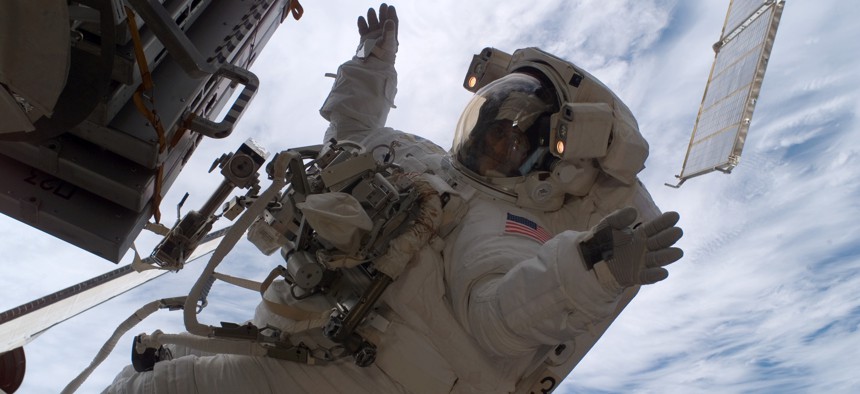
NASA astronaut Sunita Williams participated in three spacewalks. NASA file photo
For the Future Success of Space Exploration, We Need More Female Astronauts
Even in the final frontier of outer space, women are bumping into a glass ceiling.
Even in the final frontier of outer space, where the indignities and injustices of daily life would seem to float away before the vastness of the universe, women are bumping into a glass ceiling.
Out of more than 500 space travelers over the past century, women make up only about 10 percent, according to figures from the NASA and the European Space Agency. Not one of them has flown beyond low-Earth orbit, a region of space between 111 and 1,242 miles from Earth’s atmosphere.
Compare that to the 24 men whose governments have sent them a full 384,400 kilometers to the moon. And while NASA’s current astronaut class is 50 percent female, that’s far from the case in space agencies around the world, especially in Europe: Over the past 38 years, Germany has sent 11 men into space and zero women. The European Astronaut Corps, currently a 14-member team, includes just one woman.
“One reason, especially for German women, is that women only apply for a job if they are really 100 percent sure that they fit all the criteria. They’re very risk adverse with regards to applying for something where men would say, ‘Well, I’ll just go for it even if I only have 50 percent of the criteria,'” says Claudia Kessler to Quartz. Kessler is a seasoned recruiter and CEO of German space engineering recruitment company HE Space.
"Women really want to be 150 percent sure before they apply," she says.
But women may bring an invaluable dynamic to the teams exploring space.
“It’s much better for the mood of the teams if you have women,” says Kessler. “Women are much more communicative, much more integrative, much more harmonizing.”
Female astronauts are more likely to be “rebels,” “imaginers,” and “harmonizers,” personality types that emphasize creativity, compassion, and warmth according to the Process Communications Model, a personality and communications theory used for 20 years by NASA psychiatrist Terence McGuire. The model was created to predict the behaviors of the agency’s astronauts and evaluate potential for conflict within teams.
Indeed, one behavioral study at the Mars Desert Research Station in Utah found that women in a Mars simulation mission were more likely to be agreeable and conscientious, more likely to meet mission deadlines, and according to Mission Control, were easier to work with than men.
Although this study looked at female- and male-only teams, researchers noted that “growing evidence seems to support a balanced mix of both genders for optimal duration performance."
Kessler recently took one small step for equality by launching Die Astronautin or ‘The Female Astronaut”: HE Space’s private search for Germany’s first female astronaut.
The project, funded through crowdsourcing and private sponsorship, is accepting applications until April 30. After medical and psychological tests, two selected candidates will undergo training for 18 months at the Yuri Gagarin Cosmonaut Training Center in Russia before the final selection is made. Then, Kessler says, Germany’s first female astronaut will fly on a private expedition to the International Space Station by 2020.
Sending one more female astronaut into space won’t fix its gender imbalance, but Kessler says providing more female role models is an important step forward. The new German astronaut will join the ranks of Russian Valentina Tereshkova, the first woman in space; Sally Ride, the first American woman in space; and more recently, Italy’s Samantha Cristoforetti, who currently holds the women’s record for the longest single mission.
Die Astronautin program also hopes to add knowledge around what happens to women’s bodies in zero gravity—especially as space agencies and private companies race to develop the first manned missions to Mars, which takes eight months to reach one-way with current technology.
According to a 2014 study by NASA, women are more likely to experience space motion sickness and “immediate post-flight orthostatic intolerance,” an inability to stand without fainting. By contrast, they are less likely to experience ailments frequently felt by male astronauts, like hearing impairment and motion sickness when returning to Earth. Women returning from space are also less likely to suffer one of the most serious spaceflight-related health risks: long term visual impairment.
However, it’s hard to judge the significance of this difference, says NASA, precisely “due to the small number of subjects (particularly female astronauts) studied to date.”






